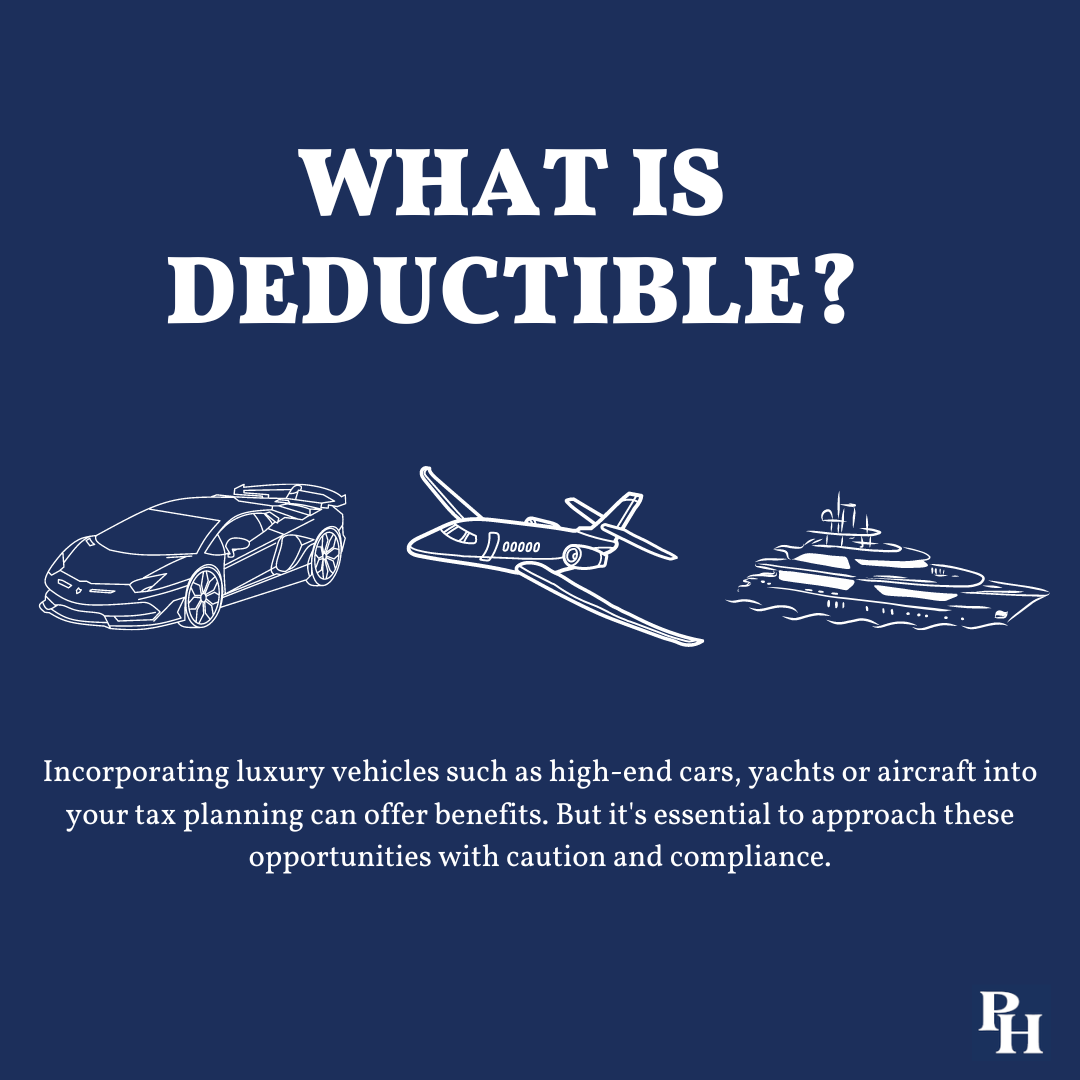
Owning luxury items like a luxury car, a yacht, or even a private jet may sound like the epitome of indulgence and success. If you plan to use these vehicles for business purposes, potential tax benefits might seem to sweeten the deal even further.
While the idea of potentially offsetting the expense of a high-end vehicle through tax deductions is appealing, it’s essential to stay on the right side of the law. Responsible tax planning is great, but actual tax evasion is illegal. Claiming luxury cars or other expensive vehicles as business expenses may draw special scrutiny from the Internal Revenue Service, making it especially crucial to comply with tax regulations. Unless the vehicles are directly tied to your business, and you can demonstrate this connection, the IRS may classify them as personal items. If you are considering a purchase on the assumption you can secure a deduction, it is prudent to be sure you understand the rules in advance.
If you plan to buy a luxury vehicle of any type for your business, the first step is to ensure that it serves a legitimate business purpose. There is no one-size-fits all test for this determination, but deductible business expenses must be “ordinary and necessary” in the tax authorities’ view. Whether a given purchase will meet this test depends on the type of business, the standards in the particular industry and the particulars of the vehicle itself. But meeting this test will serve as the bare minimum when determining whether an expense is deductible, regardless of type.
Luxury Cars: Driving Toward Tax Savings
Once you have determined a luxury car is a deductible business expense, two potential deductions are available: mileage and actual cost. Tracking miles means meticulously recording how far you drive for business purposes. As of 2024, you can deduct 67 cents per mile for business use. Opting for the actual cost method allows you to take deductions for items such as depreciation, maintenance, gas, insurance and repairs, as long as you use the vehicle for business 50% of the time or more.
Businesses can also benefit from the Section 179 deduction, allowing them to deduct the cost of qualifying equipment, including certain vehicles. Additionally, the Section 168(k) allowance, known as bonus depreciation, enables businesses to accelerate the depreciation of qualifying assets. Using bonus depreciation, a business can depreciate up to 60% of the asset’s value in 2024.
When discussing cars, it is important to note that the IRS definition of “luxury” is a bit different than the way most people would use the term in casual conversation. For tax purposes, “luxury auto depreciation limitations” apply depending largely on the vehicle’s weight, not only the dollar amount you paid for it. These limits apply to cars, light SUVs, light vans and light trucks.
In 2024, businesses may take deductions for light vehicles — those weighing under 6,000 pounds — up to $20,400 in their first year of use, including bonus depreciation. This deduction limit applies to luxury vehicles and standard vehicles alike under the weight limit. For vehicles between 6,000 and 14,000 pounds, businesses can deduct up to $30,500 in 2024, along with 60% bonus depreciation. Vehicles exceeding 14,000 pounds, or those modified for nonpersonal use, are not subject to tax limitations, so businesses may deduct up to 100% of the vehicle’s cost. Note that if you decide to lease your vehicle, you may write off your lease payments only up to the portion that is dedicated for business use.
It may help to consider an example. If you buy a BMW 7 Series, which weighs less than 6,000 pounds and is valued at approximately $97,000 at this writing, you are eligible to deduct $12,400 of depreciation in the first year. The bonus depreciation will be $8,000, bringing the total to $20,400. The balance of the car’s cost will be depreciated under the Modified Accelerated Cost Recovery System, usually abbreviated as MACRS. Because of the vehicle’s cost, full depreciation will take more than five years.
Contrast this with a larger vehicle at a similar price point. A Porsche Cayenne S Coupé weighs more than 6,000 pounds and is valued at approximately $103,000 at this writing. Because of its larger size, it would qualify for a $30,500 deduction, plus bonus depreciation of 60% of the value after the Sec. 179 allowance, which amounts to $43,500. In addition, you would be able to take regular depreciation for the year of 20% of the remaining depreciable basis, which is the cost less the Sec. 179 deduction less bonus depreciation. In this example, that comes out to $5,800. This brings the total deductible depreciation to $79,800 in the first year. (Note that, in both of these cases, we assume that the vehicle will be used 100% for business. In cases where a car is for both business and personal use, these numbers would look different.) As this example illustrates, a heavier vehicle with a similar market value to a lighter one can offer relatively greater upfront deductions because of IRS weight rules.
Keeping track of your business vehicle expenses, regardless of a car’s initial price, is essential. In the event of an audit, the IRS will expect you to support your claim that car-related deductions arise from legitimate business expenses. Be mindful that, in all the cases we have discussed, you must use the vehicle more than 50% for business purposes. The more clearly you can demonstrate this, the stronger your tax position.
Yachts: Sailing Through Tax Benefits
The feeling of sailing on a sunny day is truly one of a kind, especially in places like Palisades Hudson’s home base of Fort Lauderdale, Florida, hailed as the yacht capital of the world. With over 300 miles of inland waterways, Fort Lauderdale is home to approximately 50,000 boats and yachts, and the city attracts more than 2,000 superyachts every year.
For those considering yacht ownership, it is worth weighing the tax implications carefully. Do you plan to live on your yacht sometimes? Do you plan to use it for charters or other business ventures? Or is it purely for enjoyment? Depending on the ways you intend to use your new watercraft, a yacht may or may not create tax planning opportunities.
Your Boat As A Home
Most people think of a yacht as a place to spend leisure time, but some owners use their yachts as a second home, or even as their primary residence. In these instances, the yacht may qualify for a tax deduction on mortgage interest. At a minimum, the boat must include cooking, sleeping and toilet facilities to count as a residence. If the boat is a primary residence with these features, regular mortgage deduction rules for a primary residence will apply.
If the yacht qualifies as a second home, keep in mind that the deduction applies only to mortgage interest secured by the residence. In other words, you must have a mortgage to deduct mortgage interest. You will not qualify for this deduction if you bought your vessel outright or purchased it with some personal line of credit, such as a credit card. Additionally, if you already deduct interest paid on a more traditional second home, you cannot deduct the boat loan interest in the same year, though you may switch between them year to year if you wish. If you rent out your boat, you may still take advantage of the tax deduction as a second home. However, you must stay on the boat for at least 14 nights during the tax year or for 10% of the number of days the boat was rented.
If you use a part of the boat as a home office and you are self-employed, you can claim a deduction for the expenses associated with that space, just as you would for a home office ashore. Note that if you live in your yacht and also use it for business purposes, you will need to separate the part of the boat that is used for generating income from the part that is your primary residence. This is typically harder to prove on a boat than it is in an on-shore home, so you will need to document the separation with special care.
Your Boat As A Business
Many boat owners monetize their vessels, whether through a side hustle or as their main business. For example, you may decide to charter your boat, or offer scuba or snorkeling tours. However, as a boat is typically considered a recreational asset, you need to make sure you are not caught by the IRS’s “hobby-loss” rules.
If you plan to treat your boat as part of a business and not just a hobby, you will need to demonstrate that you have a genuine intention to make a profit, rather than just covering the costs of your time spent on the water. The key rule to qualify for business use, as with cars, is that you must use the boat for business purposes more than 50% of the time. Establishing your activities as part of a genuine business allows you to write off the boat’s maintenance, depreciation, equipment and fuel costs. However, the IRS frequently scrutinizes the boat industry, so it is especially important to keep good business records and establish an accounting system to track your business activity.
If you intend to organize any entertainment activities on your boat, like inviting clients on board for a fancy meal, you should first analyze the tax implications carefully. The Tax Cuts and Jobs Act of 2017 has made all entertainment costs nondeductible for businesses. Although you may be able to deduct 50% of your business meal expenses, you won’t be able to deduct the non-meal costs associated with the business meeting that you hold on your boat.
As we mentioned in the previous section, Section 179 allows businesses to deduct the cost of machinery and qualifying equipment. If you use your yacht for more than 50% business purposes, the yacht is also eligible for this deduction. The maximum deduction allowed for a company is $1.22 million in 2024. However, this limit is reduced by the amount that the purchased property’s costs exceeds $3.05 million. And as noted earlier, businesses can benefit from bonus depreciation for the purchase of new and used qualifying equipment. This allows them to depreciate 60% of the cost of the boat if it is placed in service in 2024. However, this percentage will decrease by 20% each year until the law is phased out in 2027.
Airplanes: Soaring With Tax Advantages
The tax treatment of owning an aircraft mirrors that of owning a watercraft, hinging largely on how you use the asset. The IRS classifies airplanes, like yachts, as entertainment assets by default. This means you must genuinely intend to generate profit and engage in business activities to qualify for tax deductions related to the aircraft.
You must prove your aircraft expenses, such as maintenance, fuel and hangar fees, are ordinary and necessary for your business operations, just as with a luxury car or a yacht. For business owners who use aircraft as a mode of transportation, demonstrating the business advantages of private air travel over commercial flights is crucial. Personal preference is not enough. However, factors such as efficient time management, access to smaller private airports, increased productivity and enhanced personal safety may help establish necessity.
Aircraft owners may face some additional complexities beyond those we’ve mentioned in the previous sections. If your plane is dedicated solely to business use, deductions work as you would expect. However, if you — or your employees, if your business has them — ever use the aircraft for any personal trips, the rules become especially complex. Personal use can range from the expected, such as using your plane to take a vacation, to the perhaps unexpected, such as bringing a nonemployee family member along with you on a business trip. If your business use is above 50% but less than 100%, you will need to navigate a complicated set of rules governing how to allocate trips with multiple purposes, trips with more than stop, and other situations. Note that, if an employee uses a company plane for personal reasons, the business must also calculate the fringe benefit amount connected to this trip and include it as compensation on the employee’s W-2 form. Because of these pitfalls specific to aircraft, it is wise to consult a tax expert with experience in this area if you will need to allocate expenses between business and personal use.
The same record-keeping requirements apply if you decide to make your aircraft available for charters. In order to deduct any costs associated with the airplane, it must be used for business purposes more than 50% of the time. Business aircraft owners can also take advantage of the Section 179 deduction, which allows them to deduct the cost of the aircraft up to a maximum of $1.22 million, along with a bonus depreciation of 60% of the aircraft’s cost for 2024.
If you use your aircraft for certain activities that are promoted by the federal government, such as research and development, you may qualify for additional specific tax credits. Further, if you offer your aircraft for charitable purposes, such as humanitarian flights or medical transport, you may be eligible for deductions related to these activities. You may want to consult a tax professional if you think these rules may apply, as they can be complex.
The concept of enjoying luxury vehicles while also using them in your tax planning can be alluring. However, we recommend that you approach these opportunities with caution and compliance. If you genuinely use your car, yacht or plane for purposes that create tax opportunities — such as the ordinary and necessary expenses we described early in the article — you should certainly claim any deductions or credits for which you qualify. Just be aware that you may face additional scrutiny from the tax authorities. Stay aware, too, of the pitfalls of hobby-loss rules. Maintaining thorough records, staying up to date with IRS guidelines and changing tax laws, and consulting a tax professional will help you navigate the troubled waters of taxation without accidentally running aground.











